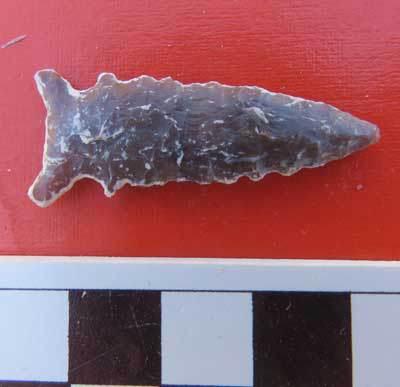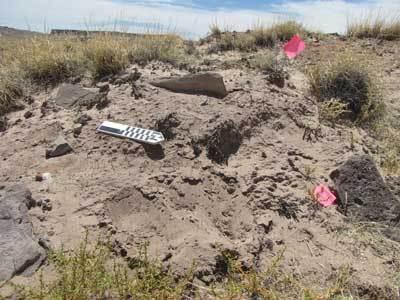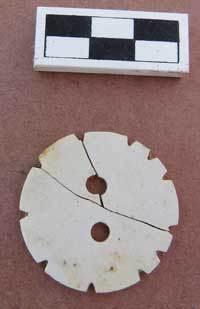Blake De Pastino
Source - http://westerndigs.org/twin-1300-year-old-villages-discovered-in-arizona-sand-dunes/
Archaeologists exploring the high desert of northern Arizona have found a pair of “matching” villages that date back some 1,300 years, revealing evidence of a crucial phase in Southwestern prehistory.
Researchers found the two large settlements — about a kilometer apart from each other — while surveying ranch land recently acquired by Petrified Forest National Park.
For the past two summers, park archaeologist William Reitze and his colleagues have been exploring the new lands to see what clues they hold about the distant past.

Archaeologists surveying land acquired by Petrified Forest National Park have found traces of two ancient villages. The flags mark a site where pottery was found.
Last year, among some grass-covered sand dunes, they found traces of a large settlement, with 50 to 75 structures ranging in size from storage cists to pithouses.
Most of the features had walls and floors lined with slabs of sandstone, an architectural style unique to the region, even though there’s no stone to be found around the village.
This summer, Reitze and his team returned to find another ancient village in dunes nearby, constructed in about the same size, and with the same distinct features.
“Last year we found a large habitation site, and this summer we found a match, less than a mile away, a site that has dozens and dozens of different features,” Reitze said.
“We have now two large groups of pithouse structures, both of them with probably more than 50 structures associated with them.”
In addition to the distinctive sandstone architecture, both sites turned up fragments of brown ceramics and stone points that are indicative of the late Basketmaker period, a cultural phase that prefigured the Ancestral Puebloans who went on to build the monuments of Chaco Canyon and Mesa Verde.

A serrated stone point is among the artifacts found at the sites. (NPS)
Indeed, last year’s survey of the ranch revealed ruins of a multistory great house that was likely part of the cultural and trade network based in Chaco Canyon.
But the two newfound villages date back to a key phase before that time — to the Basketmakers’ transition, around the year 700, from nomadic foraging to a more sedentary, agricultural, and complex society.
The evidence is less in the artifacts, Reitze said, than in the sheer size of the communities that only an agricultural lifestyle could justify, and support.
“These sites are often in large sand dunes, but there is no rock there,” he said. “So any kind of slab at all that you find out there was brought in by people.
“So they’re investing more in building structures,” he explained. “There are more folks in the same place. They’re maintaining these structures for longer periods of time.

In situ sandstone slabs of a Basketmaker feature erode from a dune. (NPS)
“They’re probably also making that investment in the landscape, with agricultural fields, water control features — you’re seeing more investment like that.”
Adding to the discovery is yet another, smaller site the team found just north of the other two, built in the same sandstone-lined style but without any sign of pottery, suggesting that it predates the use of ceramics.
“In these pre-ceramic sites, we’re seeing the same kind of thing,” he said. “We’re seeing these slab-lined features show up, we’re just not finding any ceramics associated with them.
“So then the implication would be that these are a little earlier, and they probably relate to someone who’s doing a very similar kind of lifestyle [as in the late Basketmaker sites], but they haven’t begun to incorporate ceramics into that yet.”
The question, he said, is exactly how all these sites fit together in time.
“Of course, with pithouses the difficulty is always whether or not they were occupied at the same time, or whether they represent something else.
“So are they multiple occupation events, or were they all occupied at the same time? That’s something that would require more excavation work, which is something we’d love to do in the future.”

One “really neat artifact,” Reitze said, was a white pendant carved from soapstone or siltstone. (NPS)
For now, Reitze and his team are working on securing radiocarbon dates for the sites, and weighing options for possible future excavations.
The answers from these and other investigations could shed light on the history of what Reitze says was one of the ancient Southwest’s most important crossroads.
“What’s really unique about Petrified Forest is that we sit in this major transportation corridor,” he said.
“We have the Rio Puerco running through, and we have the Little Colorado to our south. That’s why we have these large habitation sites that are probably associated with Chaco Canyon. It’s because we sit on this corridor.
“If you were to go back and forth between the Cibola heartland [in New Mexico] and the Tusayan heartland [in Arizona], you walk right through Petrified Forest.
“If you were a modern Hopi person, and you were going to go on a pilgrimage to Zuni Salt Lake, you would walk through Petrified Forest. We sit right in the middle of all of this.
“But in spite of that, we haven’t had a lot of research done. So here we have a huge amount of ceramic diversity and a huge amount of architectural diversity, and we have a really long-term period of occupation. But what’s really unique is, a lot of important questions haven’t been asked yet.
“So we can ask some of these questions, and fill in answers not only to the archaeology here, but to the archaeology throughout the northern Southwest.”